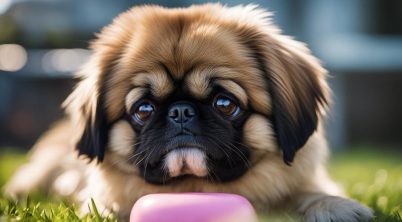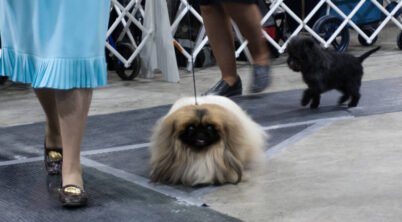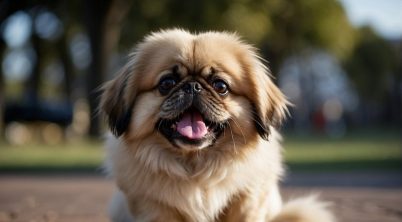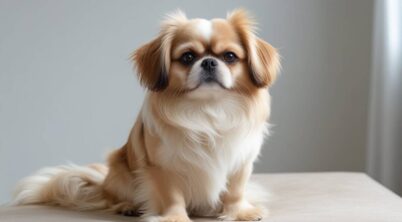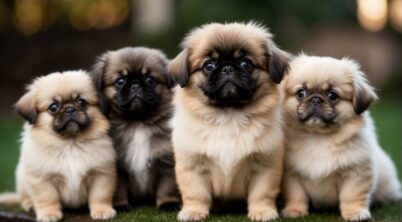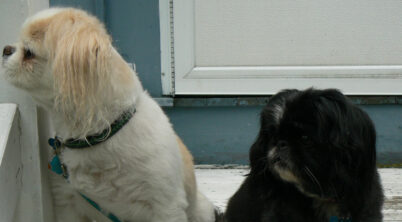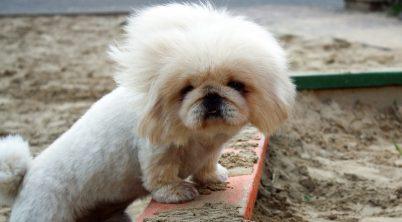The Pekingese breed hails from ancient China where it was cherished by members of the imperial court during the Tang Dynasty. With a heritage deeply rooted in Chinese regality, these small dogs were often seen in the laps of emperors and as such, were considered sacred. Their distinctive appearance, characterized by a luxurious mane and a bold, lion-like demeanor, was specifically bred to match the noble expectations of the aristocracy. The breed garnered international attention when several Pekingese were taken from the Summer Palace during the Second Opium War and one was presented to Queen Victoria, further cementing their status as dogs of high esteem.
Central to the Pekingese’s unique look is its distinct jaw structure. The breed exhibits a brachycephalic head, with a short muzzle that is broad and flat. Such facial structure leads to what is known as an undershot bite, where the lower jaw is slightly longer than the upper, giving the Pekingese its iconic facial expression. This feature not only contributes to their signature look but also influences their health and the care they require.
Understanding the complexities of the Pekingese jaw is critical for both breeders and pet owners. The breed’s revered status and physical traits are a testament to its storied past, but also present challenges in terms of dental health and breathing issues. Proper care and attention to these details help ensure that the Pekingese continues to thrive as a beloved companion, maintaining its place in the hearts of dog lovers around the world.
Table of Contents
The Pekingese Jaw
The Pekingese breed is characterized by a distinctive jaw structure, attributed to its brachycephalic head. This unique morphology has specific implications for the dog’s bite force and jaw alignment compared to other breeds.
Pekingese Jaw Strength
The Pekingese has a relatively less powerful bite force than larger breeds due to its smaller size and brachycephalic head shape. The dog’s strength in its bite is suitable for its size, but it is not recognized for a particularly powerful grip. Any bite from a Pekingese may be uncomfortable but is unlikely to be as impactful as bites from larger, more powerful-jawed breeds.
Pekingese Jaw Measurements
The jaw of the Pekingese typically features an undershot bite, where the lower jaw is slightly longer than the upper jaw. This distinct trait is a defining feature for the breed’s profile. While Pekingese jaws can vary slightly from dog to dog, the undershot appearance remains a common and recognizable aspect.
Pekingese Jaw Compared to Jaws of Other Dog Breeds
Compared to other dog breeds, particularly those with mesocephalic (medium-length) or dolichocephalic (long) heads, the Pekingese’s jaw is unique. Its brachycephalic (short) head type results in a pushed-in face with a specific jaw alignment that is different from many other breeds. The Pekingese’s bite mechanics and appearance are consequently quite distinctive.
Physical Characteristics
The Pekingese flaunts a stocky and compact body, exuding a dignified presence. Their physique is accompanied by a soft, long double coat that frames the face like a lion’s mane in a variety of colors.
Distinctive Head
The Pekingese boasts a particularly distinctive head structure, characterized by its sizable, flat skull and shorter front to back length when compared to its width. Set wide apart and ornamented with heart-shaped ears, the Pekingese’s eyes are prominent, contributing to their expressive face. The eyes are large and round, imbuing a look of alertness. The nose is broad and short, leading to a distinct, flat-faced appearance.
Their muzzle is short and wider than it is long, an extension of their flat-faced profile. They have a well-defined stop and their neck, although slightly obscured by the mane, is short and thick, blending into their deep chest and broad shoulders. This breed carries its tail over the back, with a plume of fur that adds to its regal bearing.
While the breed’s overall size is small, with a height ranging from 6 to 9 inches at the shoulder, they have a surprisingly heavy build for their stature. Pekingese typically weigh up to 14 pounds, adhering to weight restrictions set by breed standards for show dogs. Their coat colors vary and can include shades of gold, red, sable, cream, and black. The lavish double coat requires regular grooming to maintain its condition and appearance.
Breed Popularity and Ownership
The Pekingese, often referred to as the “lion dog” or “sleeve dog” due to its historical role as a lapdog in Chinese nobility, has maintained a consistent popularity as a companion dog. Its small size and amicable nature make it an ideal apartment dog, well-suited for living in confined spaces.
Popularity: Historically associated with wealth and privilege, the Pekingese has transcended its aristocratic roots to become beloved by many. The breed’s popularity is sustained today not only by its storied past but also by its affectionate demeanor and adaptability as a family pet.
Breed Group: This breed is classified in the toy group, highlighting its role primarily as a pure companion dog. Despite its modest stature, the Pekingese carries a confident and regal bearing, reflecting the breed standard which is upheld by reputable breeders and breed enthusiasts.
- Life Expectancy: Typically, the Pekingese enjoys a life expectancy of 12-15 years.
- Rescue Organizations: Numerous breed-specific rescue organizations are dedicated to rehoming Pekingese dogs and providing them with a second chance at companionship.
- Breeders: Those interested in owning a purebred Pekingese should seek a reputable breeder, one who adheres strictly to the breed standard and prioritizes health and temperament.
It is noteworthy that when obtaining a Pekingese from breeders or rescue organizations, prospective owners are contributing to the breed’s legacy and supporting ethical breeding and rescue practices. The careful selection of a Pekingese from a responsible source ensures the perpetuation of the breed’s best qualities.

